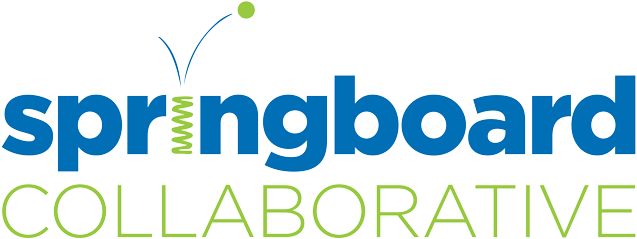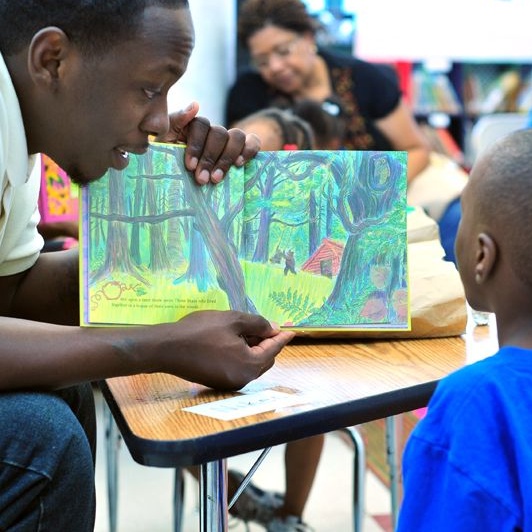 Tomiko Ball (left), an expert DCPS educator, a 2017 Honored National Teaching Award recipient, and a present doctoral candidate at American University for Ed Policy and Leadership, has been involved with Springboard Summer programming for three years in Washington, D.C. Keeping consistent with educational goal-setting, Tomiko began her pursuit of doctoral work with American University in fall 2019.
Tomiko Ball (left), an expert DCPS educator, a 2017 Honored National Teaching Award recipient, and a present doctoral candidate at American University for Ed Policy and Leadership, has been involved with Springboard Summer programming for three years in Washington, D.C. Keeping consistent with educational goal-setting, Tomiko began her pursuit of doctoral work with American University in fall 2019.
AnnMarie Schamper (right) has been a kindergarten teacher for 11 years for the Philadelphia School District.  She attended Drexel University for an undergraduate degree in Elementary Education and then went on to Cabrini University, earning a master’s in Special Education. AnnMarie is now pursuing her second master’s degree at Rosemont College in Educational Leadership. AnnMarie has been working for various Springboard programs for the past four years and has held the position of teacher and Site Leader.
She attended Drexel University for an undergraduate degree in Elementary Education and then went on to Cabrini University, earning a master’s in Special Education. AnnMarie is now pursuing her second master’s degree at Rosemont College in Educational Leadership. AnnMarie has been working for various Springboard programs for the past four years and has held the position of teacher and Site Leader.
In this two-part series, Tomiko and AnnMarie describe their experiences as both teachers and Site Leaders and their experiences hosting families and family workshops during Springboard programming.
In this blog, read about their experiences teaching for Springboard.
Tomiko and AnnMarie came to be teachers at different points in their Springboard history. Tomiko started teaching for Springboard during her first session in summer 2016. AnnMarie started teaching for Springboard in summer 2019 after being a Site Leader for three summer sessions. Even though their paths for teaching with Springboard were different, they had similarities in their experiences.
Here are some of the reasons they loved teaching with Springboard.
1. Watching students make significant reading gains
Both Tomiko and AnnMarie talked about the amazing progress that Springboard scholars make in such a short time period. Every summer, scholars are assessed and given a reading goal and every summer, we watch scholars reach and exceed their reading goals. Instead of staying at the same reading level or even sliding backward, Springboard scholars progress by an average of 3+ months of reading growth in only 5 weeks!
“Possibly most importantly, see[ing] the progress that students make in only five weeks makes teaching for Springboard Summer worth it! I could not believe how many students went up a reading level or even two reading levels when the program was over. Even for those students who may not have made it to the next reading level, it was still a success for them because they wouldn’t become part of the summer slide. They felt more confident going into the new school year and they grew into lifelong book lovers!” – AnnMarie Schamper (AMS)
“Look at the jump within a 5-week timeframe; it’s only 5 weeks and it’s so impactful. Had the students not participated in Springboard, they would be going into the school year with the idea that now teachers [during the school year] have to do all that extra work to pull them up. Any teacher would be happy to receive students at a higher reading level! The same way I experienced this as a teacher of Springboard children, I want more teachers to receive students who are working on or towards grade level.
I think that all teachers would want to know… how to elevate impact.” – Tomiko Ball (TB)
2. Getting better at small-group differentiated instruction
We believe in the power of small-group instruction and differentiation. We keep class sizes small and we group by reading proficiency, not by grade-level or age. But we also include small-group differentiated instruction during our classroom time, giving our educators a chance to focus on specific skills with their students and develop their own instructional practice.
“That summer, I got to look at [small-group differentiated instruction] in a different way and perfect my craft, moving children across levels to get them to grade level… I was able to use the lesson plans and materials from Springboard to strategically move the students.” – TB
“Teaching for Springboard has taught me a lot when it comes to [small-group differentiated instruction]. I learned so many strategies to use with my students, but more importantly, I learned how to explain these strategies to students in a kid-friendly way.” – AMS
3. Being supported with resources and training
Before programming starts, we prepare educators and leaders with professional development sessions and resources, and during programming, learning is continued through PLCs. For branch programming, we also provide coaching support throughout the program. Tomiko and AnnMarie spoke to the pre-programming professional development experiences that helped them learn about the program and beyond.
“The amount that you learn from being a part of Springboard Summer also makes it worth it. I learned more from going over information in family workshops than I did in many college classes and other professional developments. You learn new reading strategies to help move students to the next level and you learn how to best explain and teach these strategies to students and their families. I believe that being a part of Springboard Summer has made me a better teacher.” – AMS
“My first training in summer 2016, as a teacher, I was amazed because it was like I was in a graduate course for educators that was solely focused on literacy. We were using automated systems and manually analyzing students’ strengths and what students needed in order to improve. I learned there are also many resources in [Slinky, Springboard’s database system] and there are scripted lesson plans… there was no way you can be unprepared!” – TB
To close out this list, we want to share something that AnnMarie wanted to pass along:
“For those of you out there on the fence about joining the Springboard community,” she said, “Do it! You won’t regret it!”

